SPONOSORED BY: MATRIKON
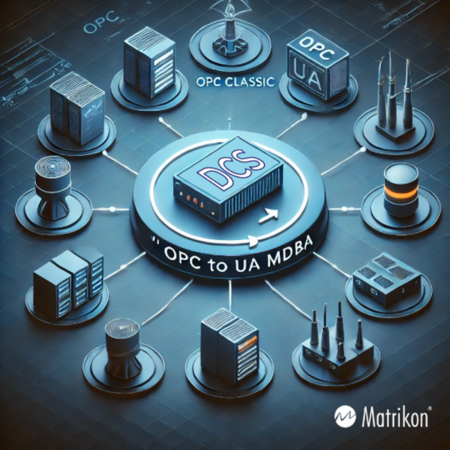
The trend of DCS vendors adopting OPC UA began to gain traction in the early 2010s and has accelerated in recent years. This fact is reinforced by ever-growing customer feedback that their forward-looking DCS vendors are moving away from OPC Classic in favor of OPC UA (Unified Architecture). This transition is not a sudden phenomenon but a response to evolving industry demands. While OPC Classic has been a reliable standard for decades, the modern industrial landscape pushes for more robust, secure, and scalable solutions. Many reasons are driving this shift. What follows is a quick look at three common drivers for moving to OPC UA and a mitigation strategy for companies still using OPC Classic.
Driver #1: Enhanced Security
One of the most significant reasons DCS companies are migrating to OPC UA is security. OPC Classic, though effective, was developed in an era when cybersecurity threats were arguably less pervasive and sophisticated by today’s standards. OPC Classic primarily relies on DCOM (Distributed Component Object Model), which has well-known vulnerabilities and is challenging to secure across firewalls and network segments.
In contrast, OPC UA is built with modern security protocols. It includes encryption, authentication, and fine-grained access control, providing a next-level defense against today’s increasingly sophisticated cyber threats targeting Operational Technology (OT) environments. For industries where critical infrastructure is at stake, the enhanced security features of OPC UA are non-negotiable.
Driver #2: Scalability and Flexibility
Another reason for the move toward OPC UA is its scalability. OPC UA was designed to be platform-independent, enabling seamless communication between devices across diverse systems, regardless of hardware or operating systems. This flexibility is critical as companies adopt more complex, interconnected architectures in their OT environments. As a result, more data from more components is being shared across the shop floor and with the rest of the enterprise, which demands a communication standard that can handle the volume. OPC UA is that standard.
On the other hand, OPC Classic can become limiting in large, distributed environments where integration between various devices and systems is key. OPC UA’s ability to handle both small and large-scale operations efficiently makes it an ideal choice for future-proofing industrial automation systems.
Driver #3: Future-Proof Interoperability
Industries increasingly adopt Industrial Internet of Things (IIoT) technologies, demanding greater interoperability between devices, systems, and software. OPC UA’s modern architecture and support for semantic data models make it an ideal choice for future-proof connectivity. While OPC Classic is rooted in legacy protocols and older infrastructures, OPC UA allows for easier integration with cutting-edge technologies, such as AI-driven analytics and cloud-based systems, ensuring that automation systems are ready for the next generation of industrial advancements.
Mitigation Strategy: How to Migrate Without Disruption
Migrating from OPC Classic to OPC UA may seem daunting, especially for companies with substantial legacy infrastructure. However, a phased approach can make this transition smooth and manageable. This is where solutions like Matrikon Data Broker (MDB) Data Technology come into play. Companies don’t need to rip and replace their existing OT infrastructure simultaneously. Instead, they can adopt a more gradual migration path by enabling their current OPC Classic servers to communicate via OPC UA.
Matrikon’s OPC to UA MDB Adapter is a practical phased migration solution. It allows businesses to leverage their existing OPC Classic servers while establishing OPC UA-based communication channels. This means companies can modernize at their own pace, reducing the risk of operational disruption while still gaining the security, scalability, and future-proofing benefits of OPC UA.
Conclusion
As DCS companies increasingly shift away from OPC Classic in favor of OPC UA, the key drivers are improved security, scalability, and the need for future-proof interoperability. While migrating may seem daunting, phased approaches—such as leveraging solutions like Matrikon Data Broker and the OPC to UA MDB Adapter —allow companies to modernize efficiently and cost-effectively. By adopting OPC UA gradually via a phased migration approach, businesses can protect their legacy investments while preparing for the future of industrial automation.
For more details on how the Matrikon OPC to UA MDB Adapter can help with your migration, visit www.matrikonopc.com/opctoua
Achieve Seamless and Secure OT Data Access Enterprise-Wide with Data Technology (DT)

In today’s industrial environments, achieving secure and consistent access to OT data on the shop floor, the IT network, and in the cloud is critical for operational efficiency and competitiveness. However, many companies still face challenges when trying to operationalize their OT data, especially from non-OPC UA-based sources. Enter Data Technology (DT)—a new category of software designed to address these challenges. With DT solutions like the Matrikon Data Broker (MDB) and MDB Adapters (MDBAs), businesses can unify their OT data and make it accessible across their entire enterprise by addressing IT/OT gaps ‘under the hood’.
At the heart of this approach is the concept of a Unified OT Data Layer (UODL), which allows companies to centrally access all OT data while also managing its context to ensure it’s best tailored for use by different consumers—whether those are applications, users, or cloud platforms. Furthermore, the UODL facilitates secure data transport across firewalls and DMZ boundaries, making enterprise-wide access seamless and sustainable.
For organizations seeking to unlock the full potential of their OT data, leveraging open-standards-based DT solutions is a crucial step toward building an accessible, secure, and future-proof infrastructure.
To learn more, visit matrikonopc.com/mdb and matrikonopc.com/mdba.
Bring non-OPC A Data Sources into a Unified OT Data Layer (UODL)
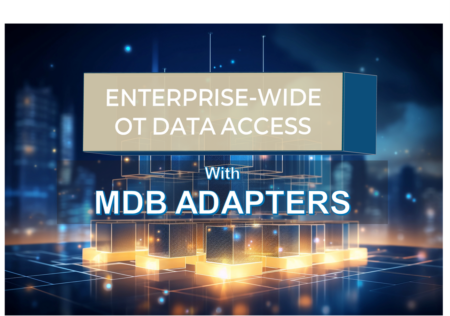
At their simplest, Matrikon Data Broker Adapters (MDBAs) act as robust OPC UA Servers as they:
- enable native communications with third-party data sources
- bring the OT data source data into a Unified OT Data Layer (UODL), significantly expanding how and where the source data can be used.
So, by plugging one or more MDBAs into MDB, you establish a flexible OPC UA Server for the specific data sources the MDBAs connect to. However, MDBAs offer more than just native OPC UA connectivity. They also open the doors to the broader capabilities of the MDB enterprise-wide data platform. This means that while you can start with simple OPC UA connectivity, you have the flexibility to expand and leverage the full suite of MDB’s advanced data integration and management features as your needs evolve.
MDBAs can be deployed as Windows applications and Linux containers (where possible) to best suit modern infrastructure needs. Using MDBAs to aggregate non-OPC UA sources also helps you build sustainable architectures via access to functionality like:
- OPC UA Reverse Connect, cross-firewall OT data communications
- Custom OPC UA information modeling and mapping
- Enhanced data context management
- and more
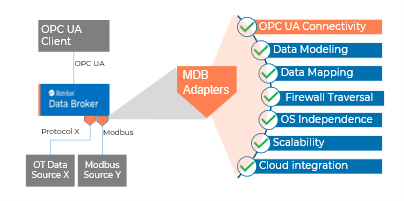
Matrikon is actively adding new MDBAs for many OT data sources. Examples of existing and upcoming MDBAs include:
- Ethernet/IP MDBA (matrikonopc.com/eip )
- PROFINET MDBA (matrikonopc.com/profinet )
- Modbus MDBA (matrikonopc.com/modbus )
- Siemens MDBA (coming soon)
- OPC to UA MDBA (matrikonopc.com/opctoua )
Discover the difference MDBAs and MDB data technology can make in your digitalization and modernization projects today!
Learn more about:
- Matrikon Data Broker (MDB): matrikonopc.com/mdb
- MDB Adapters (MDBAs): matrikonopc.com/mdba
Matrikon Early Access Program Now Open

Try out soon-to-be-released Matrikon Data Broker (MDB) components via the Matrikon Early Access program. The Early Access Program allows users to test drive new MDB functionality and provide product feedback before the products are launched. The following products are available for early access:
- Historical OPC and OPC UA data publishing over MQTT: Beyond real-time data, publish your historical OPC UA data from data sources like historians via MQTT using the Matrikon Data Broker (MDB) MQTT Publisher extension. Historical OPC Classic (HDA) may also be published by using Matrikon UA Tunneller together with the new MDB MQTT Publisher.
- MDB Adapter for Simens PLC: Get OPC UA access to your Siemens SIMATIC S7-1500 series PLCs and other models with the soon-to-be-released Matrikon Data Boker Adapter for Siemens (Siemens MDBA).
Secure your early access now. Contact your Matrikon partner or account manager or write to us at customercare@matrikonopc.com.
Stay connected and well-informed with the latest Matrikon product news and events. Click here to sign up to receive Matrikon updates in your inbox now!
Is the Matrikon OEM (MOEM) Program Right for you?
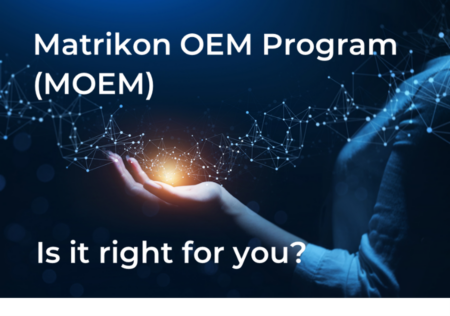
Calling all product vendors, solution builders, and software developers! Whether you need to develop native OPC UA functionality for your PC-based and embedded software or want to enhance your existing offerings by providing customers with a robust solution that ensures your offerings can securely access the OT data they rely on, Matrikon has a program just for you: the Matrikon OEM program (MOEM).
The MOEM partner program offers flexible options for businesses to use leading OPC UA-based data technology by embedding, integrating, or bundling Matrikon solutions in or with their offerings. Examples of Matrikon products included in the MOEM program include:
- Matrikon Flex and embedded Flex (Matrikon eFlex, coming September 2024), professional C++ OPC UA SDKs
- Matrikon Data Broker (MDB) Data Technology
- Matrikon Data Broker Adapters (MDBAs) and access to the MDBA API for custom MDBA development.
Learn more about how the MOEM program now:
- Visit the Matrikon OEM webpage.
- Contact Luke Gallow directly at: Gallow@matrikonopc.com
Matrikon Data Tech Day 2024 in San Francisco is on October 23rd and you are invited!
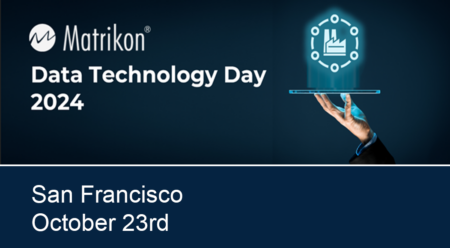
Mark your calendars for an opportunity to advance your data technology (DT) knowledge! Based on the success of the Houston event in May, Matrikon will now host another event in San Francisco on Wednesday, October 23rd, 2024. Prepare to join us, our partners and your peers at the one-of-a-kind DT-focused event, where industry pioneers, thought leaders, and users will share strategies for enterprise-wide OT infrastructure modernization.
Conference Highlights:
- Discover the latest OT Data Trends and learn how to construct robust data highways.
- Bridge the IT/OT divide and share better data using OPC UA information modeling and to-cloud solutions.
- Harness the power of AI at the edge to revolutionize your OT applications.
- Engage in insightful discussions on many more cutting-edge topics.
This is your chance to gain actionable insights and methodologies to empower your organization to securely and sustainably share OT data across all enterprise levels, using existing and new infrastructure components.
Secure your spot by contacting us at customercare@matrikonopc.com for more details or to register.